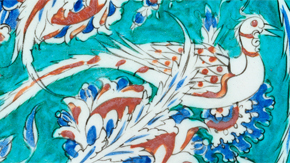At the opening dinner and private view of The Glamour of Italian Fashion 1945 - 2014, we chatted to Fausto Puglisi, Angela Missoni, Tom Ford, Bianca Jaggar, Elizabeth Hurley and others about how Italian fashion became the force that it is, and which look best encapsulates almost 70 years of Italian style.
Sonnet Stanfill:
The exhibition chronicles the rise of Italian fashion from the post-war period in the late 1940s through to the really glamorous explosion of the fashion catwalk shows in the 1950s followed by, of course, the ‘Hollywood on the Tiber’ moment in the ‘60s when so many Hollywood films were shot on location in Rome. And that leads us in to the rise of ready-to-wear - what I like to call the ‘go-go’ years of Italian fashion - when Armani was featured on the cover of Time magazine in 1982 and Italian designers really helped to change the fashion language away from couture in to designer ready-to-wear.
We conclude with a wonderful section devoted to the cult of the designer and it showcases so many big-name brands that have really, it really illustrates how designers themselves have become more famous, in some cases, than their celebrity clients.
Interviewer:
What do you think makes Italian fashion unique?
Angela Missoni:
Our history, our craftsmanship and knowledge that we have, that really make it possible.
Stefano Gabbana & Domenico Dolce:
DD: All fashion is so unique; English fashion, American, every country - it is one person’s expression about the life, the culture. Italian culture is completely different to British culture, I think the fashion reflects exactly what is the culture, the mood, the philosophy, the weather… Everything!
Elizabeth Hurley:
Well, for me, the Italians really think that women are fantastic and they design to make women even more fantastic and, obviously, I heartily approve of that. They celebrate the female form, they celebrate femininity.
Tom Ford:
The craftsmanship is incredible. There is something, I think, about growing up in Italy that is taught… it’s not even taught, I think you feel it, I think you feel the history. Whether you’re rich or poor, growing up in Italy you have an appreciation for beauty.
Bianca Jagger:
Feminine, glamorous and sexy… And elegant… It’s very difficult to combine all of those things. If I think about all of the great designers that I wear – from Prada to Roberto Cavalli, to Dolce & Gabanna and before, Valentino – there are so many great, great Italian designers.
Emilia Fox:
I think what makes Italian fashion so unique, for me, is that there is an appearance of effortlessness in the way that Italians can dress.
Stephen Jones:
I mean it’s an extraordinary history of five thousand years of gorgeousness. When we were running around in woad here, they were doing embroidery.
Julie Ann Morrison:
I think that it has a sensibility that is at once opulent and relaxed. It’s very interesting that Mr Paolo Bulgari says he makes beautiful jewels for a woman to wear to a picnic or to a ball. So, it’s that joy in beauty in any setting that I think is very Italian.
Elizabeth McGovern:
Well, the Italians have always been famous for their craftsmanship, the materials, and just a history of attention to detail.
Nicholas Coleridge:
Italian fashion different for two reasons; it’s sleeker and it’s sexier and that has actually always been the case in my opinion from about the 1960s onwards. And you can never mistake an Italian-cut dress from a French one, or even from a British one actually, come to that.
Poppy Delevingne:
Italian fashion, for me, has to be the most stand-out. They way they use colour, they always have a sense of fun about the designs and, yes, I just love wearing them.
Interviewer:
If you think of the last 70 years of Italian fashion, is there a particular highlight for you?
Giovanna Gentile Ferragamo:
You know, as usual, fashion is moving all of the time, so it really adjusts to the time we are living in, and to the needs, and to the world that is changing so fast.
Christopher Kane:
I’m a huge fan of Versace so, what can I say, the Gianni and Donatella legacy lives on. It’s just such a wonderful house, and obviously the heritage and the historical references that they have, from a small town in Italy to a huge success - it resonates with me as well. You just can’t live without that house, I don’t think contemporary fashion would be the same without Versace.
Livia Firth:
Well it has to be the ‘50s and the ‘60s – I love that era, it was glamorous in itself, you know, sometimes you watch movies from that period and you think ‘I wish I lived there’.
Fausto Puglisi:
The ‘80s and the early ‘90s were incredible for Italian fashion – from Gianni Versace to Dolce & Gabanna when they first started, and Gianfranco Ferré, as well as Georgio Armani – it was incredible. I was very young, I was a kid, but that for me represented the most incredible and iconic period for Italian fashion.
Pierpaolo Piccioli & Maria Grazia Chiuri :
MGC: We are very happy that in this moment we can see all the Italian history.
PP: There are so many moments. We are Roman, we remember very well the couture houses from Rome. But also the Florence moment with the Sala Bianca, Valentino, there are so many moments to remember and it’s important to celebrate this moment, here in London.
If you could choose one word that encapsulates Italian fashion, what would it be?:
Stefano Gabbana & Domenico Dolce:
SG & DD: Passion!
SG: For us it is ‘passion’.


